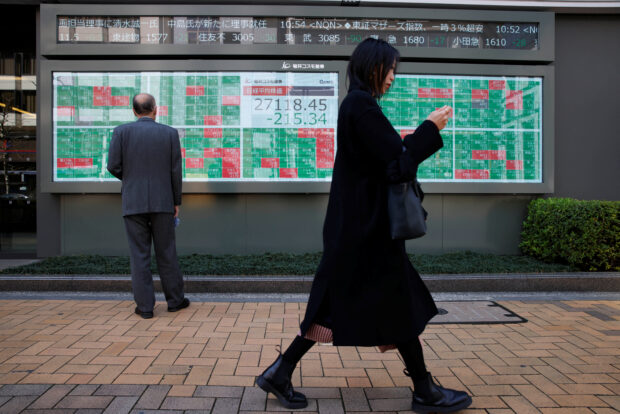
A woman walks past a man examining an electronic board showing Japan’s Nikkei average and stock quotations outside a brokerage, in Tokyo, Japan, March 20, 2023. REUTERS/Androniki Christodoulou/File Photo
SINGAPORE – Asian stocks leapt while the dollar was nursing its heaviest losses in a year on Wednesday, as steady U.S. inflation figures boosted investor confidence that the Federal Reserve was done hiking interest rates and may start cutting early next year.
U.S. headline consumer prices were flat in October, against expectations for a 0.1 percent rise. Core CPI, at 0.2 percent, also came in below a forecast of 0.3 percent.
MSCI’s broadest index of Asia-Pacific shares outside Japan was up 1.9 percent in early trade. Japan’s Nikkei was up 1.8 percent. Overnight the Nasdaq jumped 2.4 percent, bonds surged and the dollar slumped more than 1.6 percent on the euro.
“This was – unequivocally – good news on the inflation front,” Sam Rines, managing director at research firm CORBU in Texas, said in a note to clients.
“But the relevant question now is: ‘Can it get any better?'”
Interest rate futures swung sharply higher as traders priced out any chance of further rate hikes and foresaw a cut as early as May, with some chance it could come even sooner, in March.
Two-year Treasury yields, which closely track short-term rate expectations, dived more than 22 basis points (bps) on Tuesday and held steady at 4.84 percent in Tokyo trade on Wednesday.
Ten-year yields fell 19 bps overnight and touched an almost two-month low of 4.43 percent in Asia, having tumbled below support at 4.5 percent. Yields fall when bond prices climb.
In foreign exchange trade, the dollar suffered its heaviest selling in 12 months, with the sharpest losses against risk-sensitive currencies such as the Australian dollar.
The Aussie leapt 2 percent overnight and was steady at $0.6496 in Asia. The New Zealand dollar held on to a 2.2- percent gain, at $0.60. The euro broke above $1.08 and even the battered yen rallied to 150.5 per dollar.
The detail of the data offered extra cheer to investors, with evidence of rent rises moderating. Car prices fell and a downtrend in six-month annualized core inflation remained intact.
“This reading will likely confirm, in our view, that the Fed is now on hold on rates,” said Chetan Seth, strategist at Nomura.
“Recent U.S. labor market and inflation reports suggest an economy that is softening, but not collapsing, and bond yields and oil prices have moderated, thus reducing hard-landing risks (for the economy next year).”
On the other side of the world, China’s central bank boosted liquidity injections on Wednesday, although it kept the interest rate unchanged when rolling over maturing medium-term policy loans. The yuan held near a two-month high.
In Japan, the Bank of Japan stepped back and pared its regular bond buying as markets rallied. Ten-year Japanese government bond yields hit a one-month low of 0.775 percent.
U.S. retail sales data are the next focus for markets, although analysts think that even a positive number is unlikely to dampen the euphoria over the prospective end of the rate hike cycle.
“With so many disinflationary forces (including softening labor markets in the U.S. and Canada) it feels to me the market will run with this number and even a strong retail sales release … cannot derail the soft landing / 1995 vibes,” Spectra Markets President Brent Donnelly said in a note.